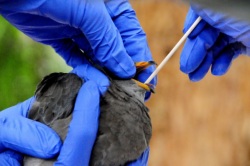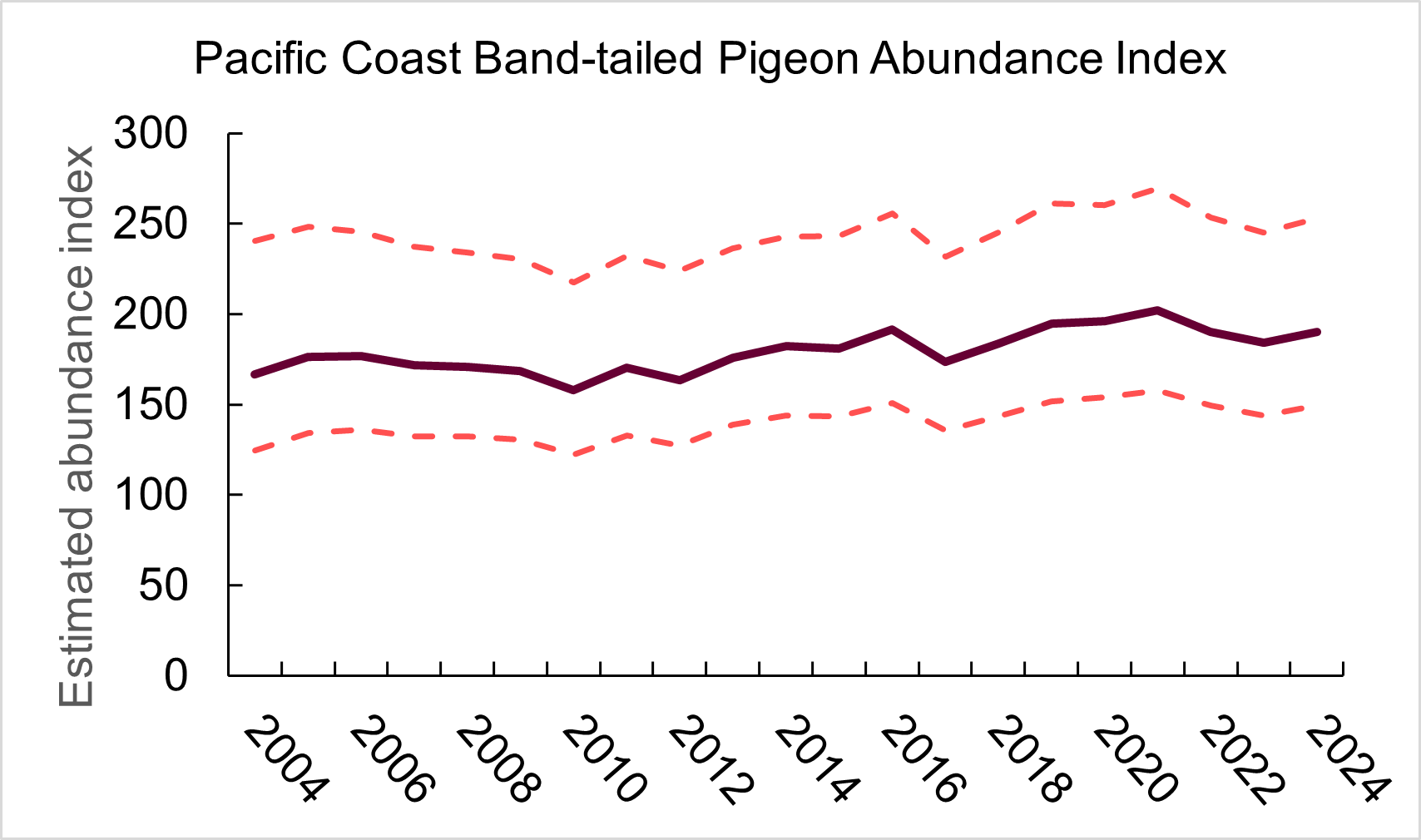 2012-13 Upland Game Bird Stamp Art by artist Clemente Guzman of Lockhart, Texas.
2012-13 Upland Game Bird Stamp Art by artist Clemente Guzman of Lockhart, Texas.
As California's only native pigeon and a close relative of the extinct passenger pigeon (Ectopistes migratorius), the band-tailed pigeon (Patagioenas fasciata) is a treasured wildlife species in California.
There are two recognized subspecies of this iconic bird in the United States; the Pacific Coast subspecies (P.f. monilis), which we have here in California and whose range also includes British Columbia, Washington, Oregon and Baja California, and the Interior or Four Corners subspecies (P.f. fasciata) which breeds in Utah, New Mexico, Arizona, and Colorado and winters in Mexico.
Conservation
The Pacific coast population of band-tailed pigeons has experienced long term population declines. The North American Breeding Bird Survey index indicates an average loss of 2% per year since 1968.
Band-tailed pigeon populations may be negatively affected by forest management practices that suppress shrub and hardwood growth in favor of maximizing conifer production. While these birds use conifers for nesting habitat, they rely heavily on fruit and nut producing shrubs and hardwoods for food during the breeding season. In addition, agriculture and urban sprawl has resulted in significant declines in valley and blue oak woodland habitat throughout California. Band-tailed pigeons use these ecosystems during the winter, where they rely heavily on acorn mast for food.
Band-tailed pigeon populations are also impacted by a low reproductive rate. They only produce one egg or chick per nesting attempt. At times when weather and food conditions are favorable, band-tailed pigeons may attempt to nest up to three times per year. However, more commonly, they produce just a single chick per year.

Another major conservation concern is the disease Avian Trichomonosis. During periodic winter die-offs, large numbers of individuals (at times in the thousands) fall victim to this disease, which is caused by the protozoan parasite Trichomonas gallinae and the newly described and named Trichomonas stableri. In work spearheaded by the CDFW's Wildlife Health Laboratory, historical accounts of this disease, and its geographic prevalence have been analyzed-- results are forthcoming.
Monitoring
Trends in band-tailed pigeon populations and harvest levels are monitored through several efforts, usually as collaborations between the USFWS, CDFW and the public. These efforts include the Mineral Site Survey, the Harvest Information Program (which includes the Parts Collection Survey) and the North American Breeding Bird Survey. The results of these surveys are compiled into an annual population status report (PDF) produced by the USFWS. Further, because California has periodic Trichomonosis mortality events, CDFW actively monitors harvested birds for the presence of disease causing protozoa and solicits reports of sick or dead pigeons from biologists, wildlife rehabilitation centers, and the public.
-
 Abundance Index (purple solid line) for Pacific Coast band-tailed pigeon (Patagioenas fasciata monilis) based on mineral site surveys, n = 63. Red dashed lines indicate upper and lower 95% credible intervals. Data from Seamans 2024.
The Mineral Site Survey: Pacific coast band-tailed pigeons regularly use mineral springs. The reasons for this behavior are likely related to the supplementation of dietary sodium but this remains an area of active research.
Beginning in 2001, the US Geological Survey formalized a survey protocol involving these mineral springs. The surveys are a collaborative effort lead by CDFW with support from the US Fish and Wildlife Service and the US Geological Survey.
Results of this survey are used to inform the band-tailed pigeon harvest management framework, which can be found in the
Pacific Flyway Management Plan for the Pacific Coast Population of Band-tailed Pigeons (PDF).
Abundance Index (purple solid line) for Pacific Coast band-tailed pigeon (Patagioenas fasciata monilis) based on mineral site surveys, n = 63. Red dashed lines indicate upper and lower 95% credible intervals. Data from Seamans 2024.
The Mineral Site Survey: Pacific coast band-tailed pigeons regularly use mineral springs. The reasons for this behavior are likely related to the supplementation of dietary sodium but this remains an area of active research.
Beginning in 2001, the US Geological Survey formalized a survey protocol involving these mineral springs. The surveys are a collaborative effort lead by CDFW with support from the US Fish and Wildlife Service and the US Geological Survey.
Results of this survey are used to inform the band-tailed pigeon harvest management framework, which can be found in the
Pacific Flyway Management Plan for the Pacific Coast Population of Band-tailed Pigeons (PDF).
- Harvest Information Program: The Harvest Information Program (HIP) is a USFWS program that conducts surveys of hunters to estimate the harvest of migratory birds.
- Parts Collection Survey: A secondary component of HIP is the Parts Collection Survey (PCS). A subset of hunters identified in the HIP survey as active hunters of a given species are requested to return one wing from each bird harvested. From these wings, biologists are able to get an understanding of the age distribution of the harvested birds.
- North American Breeding Bird Survey: The Breeding Bird Survey is an avian monitoring program administered by the USGS Patuxent Wildlife Research Center, the Canadian Wildlife Service and the National Wildlife Research Center. It is the best source of long term, large scale bird population data currently available.
Migration
The band-tailed pigeon is primarily a migratory species but there are resident groups that likely occur throughout their range. Migratory individuals breed and nest in the coniferous forests from northern California into Oregon, Washington, and British Colombia. During the winter, migratory birds co-mingle with resident populations in central and southern California.
Food Habits
 An example of typical band-tailed pigeon habitat, oak and mixed conifer forest in Monterey County. Photo by Krysta Rogers, 2011.
An example of typical band-tailed pigeon habitat, oak and mixed conifer forest in Monterey County. Photo by Krysta Rogers, 2011.
During the spring and summer, these birds feed on fruit producing shrubs of early seral stage forests. During the fall and winter, diets shift to include a greater proportion of acorns, which sustain the birds until trees come out of dormancy and new buds become an important food source.
Hunting Pacific Coast Band-tailed Pigeons
The band-tailed pigeon is classified as a migratory upland game bird by CDFW. In California, there are two 9-day seasons that are split temporally and geographically (September - northern zone, December - southern zone, zone map (PDF)). The bag limit for band-tailed pigeons is 2 and the possession limit is 6. See California upland game bird regulations.
In Oregon and Washington, the season matches that of the northern California zone, as do the bag limits. As in California, the Oregon possession limit is 6 while Washington has maintained a possession limit of 4.
For general information about band-tailed pigeons, contact CDFW's state-wide band-tailed pigeon coordinator Andrea Mott at Andrea.mott@wildlife.ca.gov.
To report sick or dead band-tailed pigeons or other birds, visit CDFW's mortality reporting page.